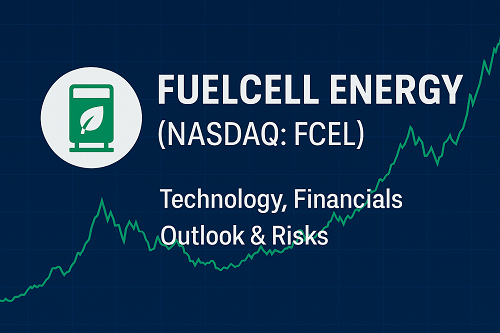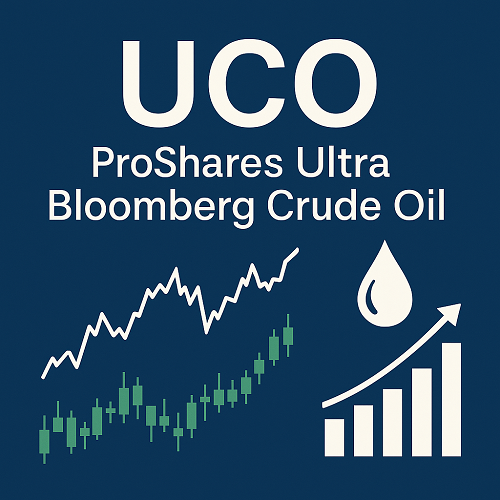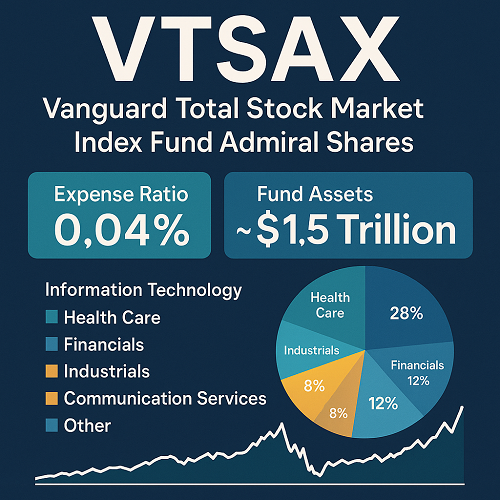FuelCell Energy, Inc. (NASDAQ: FCEL) is a U.S.-based clean technology company headquartered in Danbury, Connecticut, with a core business designing, manufacturing, operating and servicing fuel cell power plants and related systems.
Originally founded in 1969 (as Energy Research Corporation), the company now focuses on large-scale stationary fuel cell systems, hydrogen production and carbon capture solutions.
Its business model includes:
- Sale or lease of fuel cell power plant systems.
- Long-term service and maintenance contracts (remote monitoring, preventive maintenance).
- Deployment of technology on site for customers such as data centers, universities, municipalities, industrial facilities.
- Potential hydrogen and CO₂ capture applications as adjuncts to its core power generation systems.
The company emphasizes its proprietary carbonate fuel cell platform (MCFC) that can operate on a variety of fuels including natural gas, biogas and hydrogen blends.
Technology Platforms & Applications
Molten Carbonate Fuel Cells (MCFC)
The company’s primary technology is the molten carbonate fuel cell (MCFC) system, which uses a carbonate electrolyte and allows high temperature operation. This platform enables combined heat & power (CHP) applications, and offers higher efficiency than many traditional combustion-based systems.
Key features:
- Operates on multiple fuel types: natural gas, biogas, hydrogen blends.
- Generates electricity via an electrochemical process rather than combustion, thus potentially lower emissions and higher efficiency.
- Can integrate with carbon capture/sequestration: the exhaust CO₂ can be concentrated and used in industry or stored.
- Can be deployed in distributed, on-site power generation (e.g., at data centres, waste water treatment plants).
Hydrogen & Carbon Capture
Beyond power generation, FuelCell Energy is pushing into hydrogen production (via electrolysis/fuel cell reversal) and carbon capture. These offer potential “second innings” for growth as the hydrogen economy scales and decarbonisation mandates increase.
Applications & End-Markets
- Data centres and high-reliability power clients (24/7 baseload generation)
- Municipal and industrial wastewater treatment plants (used for biogas feedstocks)
- Large commercial and industrial campuses with heat/steam needs.
- Hydrogen production infrastructure and/or CO₂ capture for industrial usage.
Market Opportunity & Industry Tailwinds
Clean Energy Transition
The global energy transition toward decarbonisation, renewable energy and hydrogen presents a tailwind. Fuel cell systems are viewed as one path to reliable, on-site, low-emission baseload power generation, complementing intermittent renewables.
Growing Demand for Distributed Power
With growth in data centres, edge computing, hyperscale infrastructure and AI farms, there is heightened demand for reliable on-site power—where fuel cell systems can play a role. Indeed, one article noted FuelCell has “conversations with leading data centre developers” about baseload clean power.
Hydrogen Economy & CO₂ Utilisation
As the world commits to hydrogen strategies and carbon capture/utilisation, companies like FuelCell are positioned to benefit. If they can commercialise hydrogen production at scale and integrate capture technologies, the addressable market expands significantly.
Regional Growth – South Korea & Asia
FuelCell has operations in the U.S., South Korea and possibly other regions. South Korea is a key growth region for fuel cell installations.
Recent Financials & Key Metrics
Business Highlights
- As of Q3 FY2025, FuelCell reported results and highlighted a global backlog increase. I
- According to MarketBeat, the company has a market capitalization roughly in the hundreds of millions range, with significant operating losses.
- For example, the company’s revenue has been modest and it has yet to achieve sustained profitability.
Key Metrics
- Revenue: According to FT.com, revenue trailing-12-months ~$152.47 million.
- Net income: negative (i.e., losses) – e.g., net income ~ -$202.65 million (source: the same FT profile)
- Stock price and ranges: MarketBeat lists 52-week range approx $3.58 to $13.98.
- Analyst consensus: MarketBeat shows “Hold” rating, average price target ~$8.78 (illustrative)
Shareholders & Dilution
Given the losses and need for capital, dilution risk is meaningful. For instance, past reverse stock splits and capital raises have been used.
Valuation, Share Structure & Stock Performance
Historical Stock Performance
The stock has been volatile and has suffered sharp drawdowns from prior highs. For example, MarketWatch noted the stock was “87.66% below its 52-week high” in one past instance.
Valuation
With significant losses, valuation metrics such as P/E are not meaningful (negative earnings). Investors rely on potential future growth, backlog, contracts and the scale of the addressable market.
Share Structure & Liquidity
The company is listed on NASDAQ (ticker FCEL). Given its small market cap and history of volatility/dilution, liquidity and share structure should be reviewed carefully.
Catalysts & Growth Drivers
Here are some of the specific catalysts that could drive upside for FuelCell Energy:
- Large-scale deployments: Growth of megawatt-scale fuel cell plants sold or leased to data centres, industrial clients, utilities.
- Hydrogen / ECC (Electrolyser + Carbon Capture) ramp-up: If FuelCell unit can commercialise hydrogen production and/or CO₂ capture at scale, this would expand revenue streams.
- Strategic partnerships: International deals (e.g., with Korean firms) increase credibility and scale.
- Government incentives & policy support: Clean energy mandates, hydrogen strategies, carbon capture credits.
- Margin improvement / cost reduction: If the company can reduce manufacturing costs, improve throughput, increase margins, move toward profitability.
- Backlog growth: Reporting of stronger order backlogs or partnerships.
Risks & Red Flags
Investors should weigh the following key risks:
- Chronic losses and need for capital: The company has yet to reach sustained profitability and may require further funding, which could dilute existing shareholders.
- Technology execution risk: Fuel cell and hydrogen technologies are complex; any delays or failures in commercial roll-out hurt credibility.
- Competition: The hydrogen / clean power space is crowded with firms, including established OEMs and new entrants.
- Policy/regulation dependence: Many growth assumptions rely on subsidies, credits, favourable regulation; changes in policy could reduce the tailwind.
- Market adoption & scale-up risk: Large-scale deployments and profitability will depend on adoption, cost curves and project economics.
- Stock volatility and dilution risk: Past reverse splits and share dilutions have been a concern.
- Supply chain and manufacturing risks: Scaling manufacturing, sourcing critical components, managing costs.
- Liquidity & market perception: Small-cap nature makes the stock susceptible to sentiment, short interest, and market swings.
Analyst Viewpoints & Sentiment
- Analysts at MarketBeat give a Hold rating for FCEL, with an average price target around $8.78 representing modest upside from recent prices.
- Some commentary (e.g., via Investors.com) noted a recent rally of over 80 % in September 2025, driven by optimism around data-centre deals and Korean partnerships—but also cautioned about macro risks.
- Other analysts remain skeptical about the business model given the long path to profitability. For example, StockAnalysis highlighted “fundamentals are disastrous” in one article.
Strategic Implications for Investors
Investment thesis
If you believe that FuelCell Energy can execute on its technology roadmap, secure large backlog contracts, scale manufacturing, and benefit from the hydrogen/clean power tailwinds, then FCEL offers a leveraged way to play that theme. The upside is meaningful if the company achieves break-even and starts realising large deployments.
Cautionary approach
Given the high risk profile (losses, execution risk, dilution), this stock is better suited for speculative investors who can tolerate volatility and a long time-horizon. For risk-averse investors seeking stable cash flows or dividends, this may not be ideal.
How to trade it
- For long-term investors, tie the investment thesis to measurable milestones: backlog growth, project commissioning, margin improvement, hydrogen revenue ramp.
- For traders or shorter term, look for catalysts (earnings beats, major contracts announced, partner deals) and monitor technicals (support/resistance, volume spikes).
- Always manage risk: define stop-loss levels, understand share dilution risk and company capital-raising needs.
Conclusion
FuelCell Energy stands at the intersection of several high-growth themes: clean energy transition, hydrogen economy, distributed power for edge/data-centres, carbon capture. Its technology is differentiated, and the addressable market is large. However, the company remains in a loss-making phase, with notable execution and market risks.
For investors willing to take on higher risk in exchange for potential high reward, FCEL could be a compelling speculative play—but it’s far from a low-risk investment. Monitoring its next few quarters for production ramp-up, contract wins, and margin improvement will be crucial in validating whether this company can move from promise to performance.





 XAUT-USD
XAUT-USD  AMD
AMD  MARA
MARA  SHOP
SHOP  BULL
BULL  CL=F
CL=F